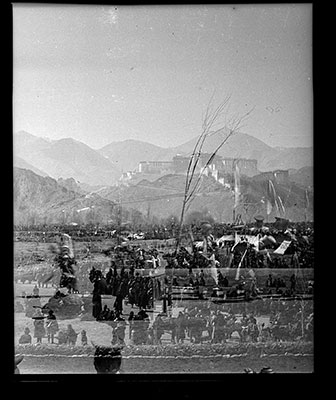
2001.59.1.95.1 (Film negative)


2001.59.1.95.1 (Film negative)

Hugh E. Richardson
Hugh Richardson
March 8th 1937
Lhasa > Meadow north of Potala
2001.59.1.95.1
54 x 43 mm
Negative film nitrate
Donated August 2001
The executors of the estate of Hugh E. Richardson
Hugh E. Richardson
Notes on negative album - '1' 'Chipsha: (?) Dzonggyab (rdzong rgyab): Torgyap (gtor rgyag)- [illegible]'
Other Information - The negative is over exposed and image not clear.[TS 9/2/2005]
Technical Information - This image seems to have been taken with a Zeiss Super Ikonta C camera. This was a 6x9 format camera but came with a film plane mask that enabled 6x4.5 images to be taken. This enabled 16 images to be taken on a roll of 120 film as opposed to 8 without the mask [MS 6/10/2005]
Other Information - Dates: In a letter to his parents dated November 6th 1936, Hugh Richardson commented that he was investigating buying a new Zeiss Super Ikonta camera [Hugh Richardson Manuscript Archive, Bodleian Library, MS. Or. Richardson 3 folio 46]. On March 29th 1937 he comments in a further letter to his parents that it would probaby be better to use the larger image frame [MS Or Richardson 3 folio 82]. This has assisted the dating of this image to 1937 [MS 6/10/2005]
Other Information - Background: See Hugh E. Richardson, Ceremonies of the Lhasa Year , 1993. London: Serindia Publications. pp. 56-7. "The name of this ceremony, the Dzongggyap Shambe, is uncertain. The common version of the spelling is rDzong-rgyab Zhabs-'bel , 'The Gallop Behind the Fort"; but there is another, rDzong-rgyab g Zhar-'phen, apparently meaning "The shooting in Succession Behind the Fort". At all events what happens is a competition between men of the Yaso's cavalry in a display of markmanship at targets suspended beside a narrow runway in a meadow north of the Potala and south of the Lhalu mansion. Tents are pitched there for the Kashag and high officials and for foreign guests; lesser officials sit on rugs on the ground in order of precedence; places are allotted to boys of the Tse school, servants of government offices and the Dalai Lama's dancing boys; and a tent is set up for the cooks who provide the refreshments, in recognition perhaps that this has been an unusually busy month for them. After the arrival of the Kashag there are the usual formalities. The Yaso present scarves to the Kashag and submit lists of the competitors; and, of course, tea is served. Each squadron provided by the noble houses then takes part separately. One after the other the horsemen ride down the runway firing with a matchlock with antelope-horn prongs at the first target, then rapidly swinging the gun round their backs they grab the bow and take an arrow from their quiver ready for the next target. Some do not have time to draw the bow but simply thrust the arrow at the target. When all the men of the right wing have finished the course there is a pause. The Dalai Lama's dancing boys collect the arrows and bring a list of hits to the Labrang Chandzo - the Treasurers of the Jokhang. The competitors then come up by squadrons and rceive scarves of different quality according to their score. Then they perform a special Mongolian salute, raising their right hand, then bending their right knee and touching the ground with their hand. They return to their horses which have been left at some distance, with cries of Lhagyallo , "Victory to the gods!" (pp. 56-7) [KC 23/10/2006]
Other Information - Setting: The Potala Palace is the winter Palace of the Dalai Lamas and the seat of traditional Tibetan government. The palace is know as several names by the Tibetan, Tse Podrang, ( rtse pho brang ) or more formally, Potala Podrang ( pho brang po ta la ) The first structure was established by the legendary Tibetan Emperor Song Gampo on Mt Marpori in 637. The original structure is said to have been 11 stories high and was destroyed by lightening during the reign of Emperor Trisong Detsen. The present structure was built by the 5th Dalai Lama on the foundation of the earliest ruins. The Potala is divided into two parts, the central upper part is known as the Red Palace ( pho brang mar p o) and the surrounding structure is know as the White Palace ( pho brang dkar po ). The Red Palace contains the main temple inside the palace and housed the reliquaries of the successive Dalai Lamas. The Red Palace also represents the original structure build in the 7th Century. Between 1645-1653 the 5th Dalai Lama added the White Palace and made it the seat of his government. Since the 17th Century, the White Palace has formed the main administrative offices of the Tibetan government and it became the seat of Tibetan government only in the 18th Century when the 5th Dalai Lama shifted his base from Gaden Palace in Drepung monastery to the Potala. There are said to be over 1000 rooms and over 200,000 images inside. The grounds of the Potala also housed a school known as Tse Lobdra ( rtse slob grwa ) 'The Peak School'. The students were mostly boys from aristocratic families and trained to become government officials. The palace was also the site of two printing presses the older one known as Ganden Phuntsog Parkhang ( dpa’i ldan phun phyogs par khang ) founded in the 17th Century and in 1920s the 13th Dalai Lama established the Shol Printing House ( zhol par khang ). [TS 27/6/2005]
For Citation use:
The Tibet Album.
"Crowds gathering behind Potala Palace"
05 Dec. 2006. The Pitt Rivers Museum.
<http://tibet.prm.ox.ac.uk/photo_2001.59.1.95.1.html>.
For more information about photographic usage or to order prints, please visit the The Pitt Rivers Museum.
© The Pitt Rivers Museum